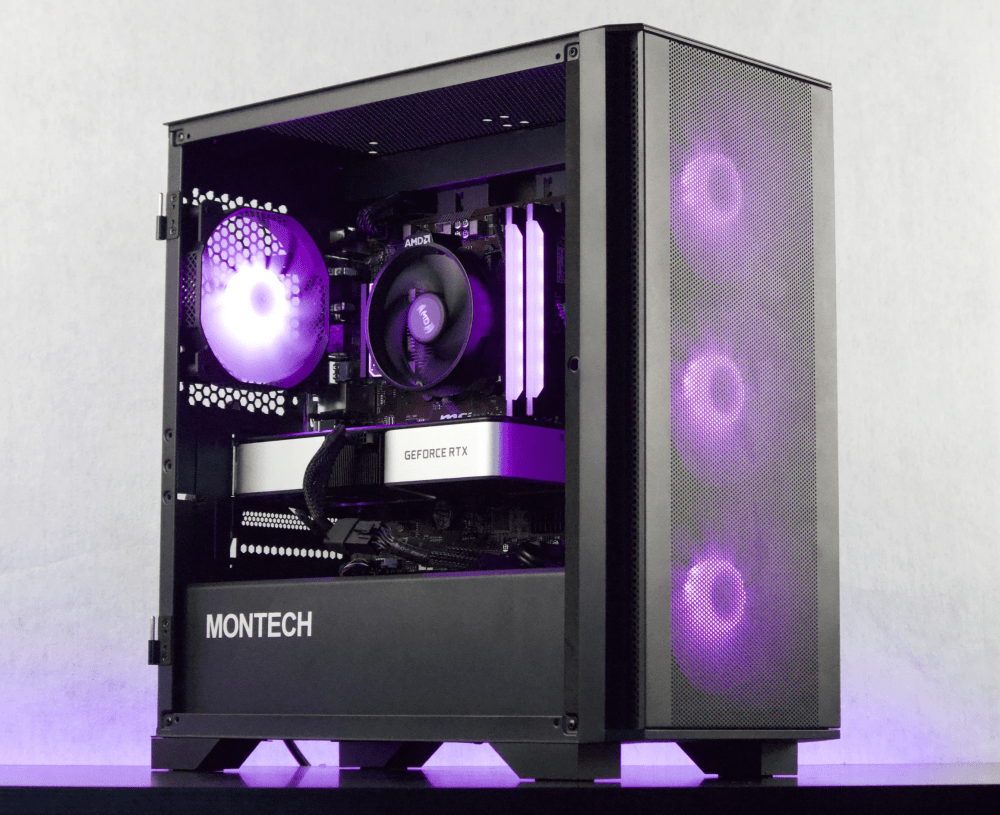If you're a gaming enthusiast or someone who heavily relies on their graphics card for demanding tasks, you may have encountered issues with high temperatures or decreased performance. One often overlooked solution to these problems is repasting your GPU.
In this guide, we will take you through the process of repasting your GPU step by step, ensuring that you have a clear understanding of what repasting entails and why it is necessary. We will also provide you with the tools you need, safety measures to consider, and guidance on cleaning your GPU before applying new thermal paste.
Choosing the right thermal paste and applying it correctly is crucial to ensure optimal heat transfer and extend the life of your GPU. We will walk you through the process of selecting the right thermal paste for your GPU and guide you on how to apply it correctly. Additionally, we will cover the reassembly process and offer tips on maintaining your GPU after repasting.
Whether you're an experienced tech enthusiast or a beginner looking to take better care of your GPU, this blog post will provide you with all the information you need to successfully repaste your GPU and keep it running at its best. So let's dive in and learn how to repaste a GPU like a pro!
Understanding the Basics: What Repasting a GPU Means and Why it's Necessary
When it comes to understanding the basics of repasting a GPU, it's essential to grasp what repasting means and why it is necessary for optimal performance.
What is Repasting?
Repasting refers to the process of removing the existing thermal paste on the GPU and replacing it with a fresh application. Thermal paste, also known as thermal compound or thermal grease, is a crucial component that facilitates heat transfer between the GPU die and the cooling solution, such as the heat sink or cooler. Over time, the thermal paste can dry out, become less effective, or develop air bubbles, leading to increased temperatures and reduced performance.
Why is Repasting Necessary?
Repasting your GPU is necessary for several reasons:
-
Heat Dissipation: The primary purpose of thermal paste is to fill in microscopic imperfections between the GPU die and the cooling solution. This allows for better heat transfer, ensuring that the heat generated by the GPU is efficiently dissipated. Over time, the thermal paste can degrade or dry out, compromising its ability to facilitate effective heat dissipation.
-
Temperature Reduction: When the thermal paste becomes less effective, it can result in higher GPU temperatures. Elevated temperatures can lead to thermal throttling, where the GPU reduces its clock speed to prevent overheating. This can cause performance drops and affect the overall gaming or computing experience.
-
Extended GPU Lifespan: By maintaining lower temperatures through proper repasting, you can potentially extend the lifespan of your GPU. Excessive heat can cause accelerated wear and tear on the GPU components, leading to a shorter lifespan. Repasting helps in reducing temperatures and ensuring the GPU operates within safe limits.
-
Improved Performance: When a GPU runs at cooler temperatures, it can maintain higher clock speeds for longer periods. This results in improved performance during demanding tasks such as gaming, video editing, or rendering. Repasting your GPU can help restore and even enhance its performance capabilities.
Understanding the importance of repasting a GPU and its impact on heat dissipation, temperature reduction, extended lifespan, and improved performance is crucial before diving into the repasting process. Now that we have a solid foundation, let's move on to the next section: preparing to repaste your GPU.
Preparing to Repaste Your GPU
Before you embark on the process of repasting your GPU, it's important to make adequate preparations. This section will guide you through the necessary steps to ensure a smooth and successful repasting experience.
Why Repasting is Necessary
Understanding why repasting is necessary will help you appreciate the importance of this process. As mentioned earlier, thermal paste can degrade over time, leading to decreased heat transfer efficiency. This can result in higher GPU temperatures, reduced performance, and potentially even hardware damage. By repasting your GPU, you can restore optimal heat dissipation and improve overall performance.
Tools Needed for Repasting
To successfully repaste your GPU, you will need the following tools:
-
Isopropyl Alcohol (90% or higher): This is used for cleaning the GPU die and removing the old thermal paste. It helps to dissolve and remove any residue, ensuring a clean surface for the new application.
-
Lint-free Cloth or Coffee Filters: These are used to apply the isopropyl alcohol and wipe away the old thermal paste. They should be lint-free to avoid leaving any fibers or particles behind.
-
Thermal Paste: Selecting the right thermal paste is crucial for optimal performance. There are various options available, including silicone-based, metal-based, and ceramic-based thermal pastes. Consider factors such as thermal conductivity, durability, and ease of application when making your selection.
-
Small Spatula or Plastic Card: This tool is used to spread the thermal paste evenly on the GPU die. A small spatula or a plastic card (such as an old credit card) works well for this purpose.
-
Rubber Gloves: Wearing rubber gloves during the repasting process helps to prevent any oils or contaminants from your hands from transferring onto the GPU die.
-
Screwdriver Set: Depending on your GPU, you may need a screwdriver set to remove the cooling solution and access the GPU die. Make sure you have the appropriate screwdriver sizes for your GPU model.
-
Anti-static Wrist Strap (Optional): While not mandatory, using an anti-static wrist strap can help prevent electrostatic discharge (ESD) when working on your GPU, reducing the risk of damaging sensitive components.
Safety Measures to Consider Before Repasting
When working with your GPU, it's important to take certain safety measures to protect both yourself and your hardware:
-
Power Off and Unplug: Before starting the repasting process, power off your computer and unplug it from the wall outlet. This ensures your safety and prevents any accidental damage to your system.
-
Work in a Static-free Environment: Find a clean, static-free surface to work on. Avoid working on carpets or other surfaces that generate static electricity, as this can damage your GPU.
-
Handle the GPU with Care: GPUs are delicate components, so handle them with caution. Avoid applying excessive force or dropping the GPU, as this can cause irreversible damage.
By understanding the importance of repasting, gathering the necessary tools, and taking appropriate safety measures, you are now ready to move on to the next section: cleaning your GPU before repasting.
How to Clean Your GPU Before Repasting
Before repasting your GPU, it is crucial to thoroughly clean the GPU die and remove any remnants of the old thermal paste. This section will guide you through the steps necessary to ensure a clean and optimal surface for the new thermal paste application.
Steps to Safely Remove Old Thermal Paste
-
Prepare the GPU for Cleaning: Start by removing the GPU from your computer case. If you are unsure how to do this, refer to your GPU manufacturer's instructions or consult online resources for guidance specific to your model.
-
Disassemble the Cooling Solution: To access the GPU die, you will need to remove the cooling solution, which is typically held in place by screws or clips. Use the appropriate screwdriver or tool to carefully remove the screws or release the clips. Take note of the screws' placement and any cables connected to the cooling solution for easy reassembly later.
-
Use Isopropyl Alcohol (IPA): Put on your rubber gloves and dampen a lint-free cloth or coffee filter with isopropyl alcohol (IPA). Avoid using excessive amounts of IPA to prevent liquid from seeping into the GPU components. Gently wipe the old thermal paste off the GPU die and surrounding areas, applying a bit of pressure if necessary. Ensure that the GPU die is completely clean and free from any residue.
-
Remove Stubborn Thermal Paste: If the thermal paste proves difficult to remove, you can use a small amount of isopropyl alcohol on a cotton swab or q-tip to target specific areas. Be cautious not to drip or spill any alcohol onto other components.
-
Clean the Cooling Solution: While you have the cooling solution removed, take the opportunity to clean it as well. Wipe away any dust, debris, or old thermal paste from the heat sink or cooler using the lint-free cloth or coffee filter dampened with isopropyl alcohol. Ensure it is completely clean before moving on to the next step.
-
Allow for Drying Time: After cleaning, allow the GPU die and cooling solution to dry completely. This will ensure that no moisture is present when applying the new thermal paste.
By following these steps, you will have successfully removed the old thermal paste from your GPU and cleaned both the GPU die and the cooling solution. Next, we will explore how to choose the right cleaning solvent for this process.
How to Apply the New Paste
Once you have cleaned your GPU and removed the old thermal paste, it's time to apply the new paste. This section will guide you through the process of choosing the right thermal paste for your GPU, how to apply it correctly, and the steps for reassembling your GPU.
Choosing the Right Thermal Paste for Your GPU
When selecting thermal paste for your GPU, there are a few factors to consider:
-
Thermal Conductivity: Look for thermal pastes with high thermal conductivity. This property determines how well the paste transfers heat from the GPU die to the cooling solution. Higher thermal conductivity values generally result in better heat dissipation.
-
Durability: Consider the longevity of the thermal paste. Some pastes may dry out or become less effective over time. Look for options that offer long-term stability and durability to avoid frequent repasting.
-
Ease of Application: Opt for thermal pastes that are easy to apply and spread evenly. Some pastes come with applicators or syringes that simplify the process. Consider your comfort level and the specific requirements of your GPU when making your choice.
How to Apply Thermal Paste Correctly
Follow these steps to apply the thermal paste correctly:
-
Prep the GPU Die: Ensure the GPU die is clean and dry. If necessary, use a lint-free cloth or coffee filter with isopropyl alcohol to remove any remaining residue.
-
Applying the Thermal Paste: Depending on the type of thermal paste you have, apply a small pea-sized dot or a thin line of paste directly onto the center of the GPU die. Avoid applying too much paste, as it can lead to excessive squeezing and potential spills.
-
Spreading the Paste: Use a small spatula or a plastic card to spread the thermal paste evenly over the GPU die. Gently glide the spatula or card in a smooth motion, ensuring that the paste covers the entire surface without any gaps or excess.
-
Reassembling the Cooling Solution: Carefully place the cooling solution back onto the GPU, aligning it with the screw holes or clips. Secure it in place by tightening the screws or reattaching the clips, ensuring a snug fit.
Reassembling the GPU After Repasting
Follow these steps to properly reassemble your GPU:
-
Reconnect Cables: If any cables were disconnected during the disassembly process, make sure to reconnect them to the appropriate ports on the GPU or motherboard. Double-check that all connections are secure.
-
Secure the GPU: Carefully place the GPU back into its slot in your computer case. Ensure that it is seated properly and aligns with the PCIe slot. Use screws or clips to secure the GPU in place, following the manufacturer's instructions.
-
Power On and Test: Once you have reassembled your GPU, power on your computer and monitor the temperatures. Use monitoring software to ensure that the GPU is running at optimal temperatures and that there are no immediate issues.
By following these steps, you will have successfully applied the new thermal paste to your GPU and reassembled it. In the next section, we will explore how to maintain your GPU after repasting for optimal performance and longevity.
Maintaining Your GPU After Repasting
After repasting your GPU, it's important to maintain it properly to ensure optimal performance and extend its lifespan. This section will cover some key aspects of maintaining your GPU after repasting.
How Often Should You Repaste Your GPU?
The frequency of repasting your GPU depends on various factors, including the quality of the thermal paste used, the GPU's operating conditions, and your usage patterns. As a general guideline, it is recommended to repaste your GPU every 1-2 years. However, if you notice a significant increase in temperatures or a decline in performance, it may be necessary to repaste sooner.
Monitoring GPU Temperature
Keeping an eye on your GPU's temperature is crucial for preventing overheating and ensuring optimal performance. You can use monitoring software such as MSI Afterburner, GPU-Z, or HWMonitor to track the temperature of your GPU. It's important to regularly check the temperatures during gaming or other demanding tasks to ensure they remain within safe limits.
Best Practices for Extending GPU Life
To maximize the lifespan of your GPU and maintain its performance, consider the following best practices:
-
Dust Management: Dust accumulation can hinder airflow and increase temperatures. Regularly clean your computer case, fans, and GPU heatsink to prevent dust buildup. Consider using compressed air or a computer vacuum to remove dust effectively.
-
Proper Ventilation: Ensure that your computer case has adequate airflow and proper ventilation. This includes having sufficient intake and exhaust fans, managing cable clutter, and positioning your computer in a well-ventilated area.
-
Avoid Overclocking: While overclocking can boost performance, it also increases heat output and places additional stress on the GPU. If you choose to overclock, do so cautiously and ensure that temperatures remain within safe limits.
-
Regular Driver Updates: Keep your GPU drivers up to date by regularly checking for updates from the manufacturer. Updated drivers often include performance improvements and bug fixes that can enhance the overall stability and efficiency of your GPU.
-
Maintain a Stable Power Supply: Fluctuations in power supply can potentially damage your GPU. Ensure that your power supply is stable, providing sufficient and clean power to your system. Consider using a high-quality power supply from a reputable manufacturer.
By following these maintenance practices, you can prolong the life of your GPU and maintain its performance even after repasting.
Congratulations! You've reached the end of our comprehensive guide on how to repaste a GPU. By understanding the importance of repasting, preparing your GPU, cleaning it properly, applying the new thermal paste correctly, and maintaining it effectively, you are equipped with the knowledge and skills to keep your GPU running at its best.
Remember, repasting your GPU is an investment in its longevity and performance, so don't neglect this essential maintenance task. Happy gaming and computing!
Looking to upgrade your GPU? Check out Jawa for killer deals on new and used graphics cards.





